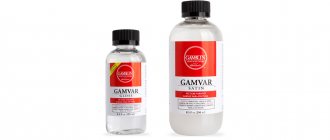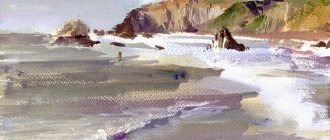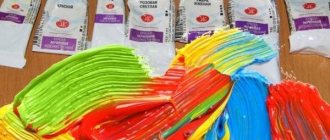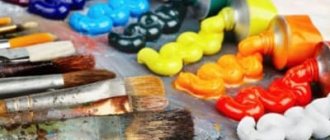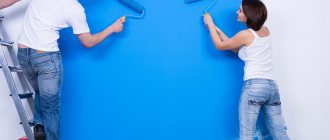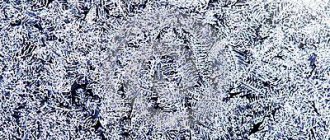Features of oil paints
Oil paints are similar to others and at the same time different. The pigments present are the same as in all types of paints. They determine the paint color, shades, and are organic, mineral, synthetic, earthen.
Their main features:
- Flaxseed oil included. Thanks to him, oil paints are bright and rich.
- Long drying time. This quality allows you to correct the work many times, correct it, change new layers, apply others on top of existing ones, create smooth transitions, unique light and shadow effects.
- Such paints are diluted not with water, but with special solvents and linseed oil.
Oil paints come in varying degrees of transparency. This property is indicated by a square on the tube: the more it is painted, the denser the paint. Durability is indicated by asterisks: the more there are, the longer the properties of the paint on the canvas are not lost.
Marking: light fastness and hiding power
In terms of quality and, accordingly, cost, paints can be highly artistic, studio or sketch. It is better for a beginning artist to purchase sketchbooks to learn how to draw. They are cheaper, and in the first stages of training, a lot of material is spent before acquiring skills.
Colorful abundance
Today, art stores, office departments and a whole legion of online sites are ready to provide us with a huge amount of paint. And a variety of types, characteristics and qualities.
Naturally, a beginner may be confused by this variety of paints for painting. Not only are there so many types of them, but each company also has its own categories and names of paints and colors! How can you remember everything, figure it out, choose exactly what you need?
Professional artists can immediately name what they need, and choosing the necessary material for drawing can only take them 15-20 minutes. Things are completely different for a beginning artist, or even a child who wants to draw, but does not know what is needed for this.
The variety of paints available today will help you choose exactly what you need. And if you have not yet decided on the main material of your creativity, it is better to try different types of paints to understand what you are most drawn to, and only then purchase them thoroughly and professionally.
By the way, it is not at all necessary to immediately buy some expensive paints; you can try a cheaper option or a student set with small tubes to save money on other paints. You can also go to several painting master classes. They usually already give out all the materials and you don’t need to buy anything yourself. Well, if you are still determined, then read my article and go to the store to buy paints!
What do you need for oil painting?
Getting started with creativity is easy. Specialty stores have everything an artist will need.
Minimum set of colors
At first it is better to buy paints as a set. Then, when it becomes clear which colors are needed more, others are purchased additionally. Consumption depends on the color scheme preferred in the work and the size of the painting.
If purchased separately, paints of the following colors should be present:
- zinc or titanium white
- raspberry alizarin;
- cadmium yellow;
- yellow ocher;
- cadmium red;
- ultramarine blue;
- Martian black.
All other colors are created from the listed shades. Whitewash will be needed more than other paints; they are greatly consumed when mixed. The color is displayed by a stripe on the tube, indicated by words.
Canvas
Classical painting involves drawing on canvas. This is fabric that has been primed and stretched over a frame. Linen canvases are considered to be of higher quality and more durable.
Requirements for the canvas: does not sag, stretched tightly, with a smooth surface. The wooden subframe is dry and durable.
Pay attention to the graininess. It refers to the presence of irregularities and knots in the weave of the fabric. If there are many of them, the threads are thick and the grain size is high. On such a canvas it is better to paint objects that have a clearly defined structure. These include: stones, rocks, trees with thick trunks, etc. You can apply large strokes to such a canvas using a palette knife.
If the objects have a delicate texture, delicate light-and-shadow transitions, choose a fine-grained canvas. It is more suitable for beginner artists. It is easier to draw a sketch on such fabric with a pencil and erase the unsuccessful fragment.
Brushes
Brushes are the main tool of an artist, so their choice is approached responsibly. Oil painting, at first, is done with flat brushes. Later, instruments of a different shape are acquired: linear, fan, retouching.
Depending on the type of pile, brushes can be bristle or kolinsky. The latter are the highest quality. To make them, the tip of the column tail is used. They are expensive, so if you want to save money, you can buy brushes made from pig bristles. There are also high-quality instruments made from synthetic material on sale.
Tools vary in size. To begin with, it is better to purchase brushes numbered in pairs from 2 to 12. Gradually you will understand which ones are more convenient to work with. When purchasing, you need to inspect how well the lint is clamped in the handle. If it comes out of the brush, it will be difficult to write.
To ensure that the tool lasts a long time, it should be looked after after use:
- first washed with solvent;
- wipe with a cloth;
- washed in warm water with soapy foam;
- wipe dry.
Store in an upright position with the pile aligned upwards.
Lucky
The main use of varnish is to coat a well-dried painting. It protects the canvas from mechanical damage, exposure to the sun, moisture, and temperature. It is easy to remove dust from such a surface.
In addition, they work with artistic varnishes while painting. Most are based on soft resins. Periodically, the brush is dipped into varnish, then into paint - this adds brightness and richness to the image. The technique is called “painting on varnish.” Solvents
Thinners
To dilute oil paint, use special liquids. Mainly this
- highly refined linseed oil;
- turpentine;
- tee;
- mediums (on the foreign market).
Turpentine and white spirit are not used for diluting paints: they destroy the structure and lose shine. It is used only for cleaning brushes, other tools and hands.
Oil can
For convenient work with the thinner, there are oil nipples. These are small containers that have a clip for fixing to the palette. They are made of plastic or metal. It is convenient to use oilers with threaded caps, since nothing spills from them and does not dry out prematurely.
Palette knives
This is what artists call spatulas, which they use to remove paint from a palette or excess paint from a canvas. Used by some painters instead of a brush, they leave voluminous strokes. 1 palette knife is enough, but if you use it as a tool for applying paint, buy it in several shapes and sizes.
Palette
Palettes are used for placing and mixing paints and attaching oil cans. The shape and parameters are chosen so that it is convenient to place the paint along the edges and mix it in the center. They are made of wood or plastic.
Easel
The canvas is fixed on the easel. It is more convenient to work with it than without it: you can install the picture at an angle and at a height, optimal for viewing. Periodically, the artist steps away from the easel to evaluate the work.
When buying a product, they look at the fastening and the strength of the structure. You can work sitting or standing; there are desktop models.
Sketchbook
To practice painting outdoors, you will need a sketchbook. This is a small suitcase with a lid and straps to hold everything you need. They differ in size and the presence of height-adjustable legs.
Sketchbooks are chosen to be large enough to accommodate paints, canvases, solvents, and brushes.
To wash tools and hands in nature, stock up on rags, napkins, and jars.
Animal skulls
The most difficult of all of the above is to get animal skulls. Taxidermists and the vastness of eBay come to the rescue in this matter. I am sensitive to animals, but I couldn’t resist the opportunity to experiment. Moreover, the seller swore that all the animals (in this case, roe deer) died a natural death and without his participation.
Any skull must be processed, bleached and degreased.
So, the easiest way to process a skull is to boil it in water, after keeping it under waste water for 20 hours. Under no circumstances put the skull in boiling water, heat it with water, and the water should cover the skull completely, but not touch the horns , If there are any. You can add a little table salt to the water, about 10 grams per liter. When boiling, you should remove the resulting foam and add water to maintain the level during evaporation, otherwise, under the influence of steam, the open part of the skull will darken. It is advisable to change the water at least every hour, and the entire cooking time lasts from 1.5 to 3.5 hours, depending on the size of the animal.
To degrease, the skull needs to be kept in gasoline for a day, again to the level of the horns, and then boiled again. Afterwards, for whitening, polish with fine sandpaper and wipe with chalk powder. To complete the process, talc should be applied to the bone and covered with a thin layer of colorless varnish.
Oil painting technique
To take your first steps in painting, you should know how to paint with oil paints.
An oil painting is painted according to standard rules. The step-by-step plan is:
- A sketch is applied to the canvas.
- Distribute light and dark areas, shadows, highlights.
- Draw the background and large objects.
- Perform detailing.
Basic rules and tips for beginners
Of course, there are a huge number of painting techniques today. At the same time, for a novice artist it is recommended to adhere to certain universal principles of work, which are often used by experienced craftsmen.
- Set up your own corner if you paint indoors. Find a place with sufficient lighting and set up an easel there. If there is little natural light, add artificial sources. The light should fall on the easel.
- Don't be afraid to experiment and mix colors. Adding white makes the shades lighter, adding black makes the shades darker. But you shouldn’t get too carried away - some shades become cloudy due to white. Black color is rarely used by artists; many use soft, delicate indigo.
- Working with oil paints is a multi-layer technique. The main principle of its implementation: the new layer should be thicker than the previous one. In this regard, it is advisable to dilute each subsequent layer less and less with oil or other thinner.
- You can edit and refine the picture over a long period of time. There is time to comprehend the work, especially to evaluate the quality of gradient color transitions. Wet paint can be removed with a palette knife and painted differently.
- While the compounds are wet, they can mix. This will be appropriate when it is necessary to make smooth transitions of colors, and not applicable if contrasts of colors are needed. In the latter case, you need to wait for the paints on the canvas to dry completely, which depends on the thickness of the applied layers, but usually takes no more than 3 days.
- The final varnish is applied to the canvas after 3-6 months, when the canvas is completely dry.
With a single-layer technique (alla prima), there is a danger of cracks from compressing the paint, so paint is applied in at least 2 layers.
Knowing the rules of this little guide, you can get to work.
Recommendations for choosing a topic
Before starting work, choose a topic. It is easier for beginners to start with still life. If they paint from life, they choose objects that will not change during the time spent on painting. A good option is to copy a drawing with few small details. It’s better not to start with a portrait; it’s difficult to create one without skills.
Some beginning artists choose landscape. First they draw the background, then move on to small details.
It is better to photograph a landscape from nature so that changes in lighting and weather do not affect the result.
When drawing flowers, choose simple shades and shapes: sunflowers, daisies, lilacs, asters. It is important not to convey the form as much as the impressions.
How to create a sketch correctly
After applying the paints, it is difficult to see the outlines of the future drawing, so its contours are first marked on the canvas. There are several techniques for creating a sketch:
- Draw lines with diluted paint. No insulation from subsequent layers is required - the materials are identical.
- Make a sketch with soft charcoal. It is separated from the next layer with a fixer.
- The drawing is done with a pencil, then a transparent primer or fixer is applied. An additional layer will hide cracks in the canvas that could appear from sharp graphite.
- Translation using carbon paper. They draw on paper, fix the sheet of paper on the canvas, placing a carbon copy. Follow the drawing with a ballpoint pen.
Fix the sketch with a fixative (special composition) or a transparent primer, which can be found in an artist supply store.
Working with color
The artist's kit may not contain the paint of the desired shade. To create a uniform color, the compositions are thoroughly mixed. You can also mix it partially - then the veins are visible in the base, giving the picture originality.
To obtain the desired color tone, mix 2 or more primary colors. A special color palette table will help beginning artists. It tells you which tones to combine to get the desired color. After practicing using the table, they try to create a personal palette for painting.
To work between 2 gradations, use a clean brush each time. It is better to do smooth transitions of colors with flat brushes, since it turns out worse with round brushes.
The technique of oil painting is not so difficult that you can't test your skills. If you have imagination and creativity, everything will work out.
Creating a Creative Environment
The psychology of creativity defines the creative process as a non-adaptive activity aimed at finding one’s own unique solution. A person is prompted to this search not by the desire to comply with social orders, not by the desire to satisfy everyday needs, but by the internal need for aesthetics and the willingness to develop, following his own unique path.
Improving artistic abilities is closely related to sensory intelligence, so beneficial effects on the senses help to consciously tune into the creative process. Ideally, it should flow easily and freely, obeying the delicate prompts of intuition, without regard to the opinions of other people and without hope of reward.
Say no to a filling lunch
The expression “An artist must be hungry” is on everyone’s lips.
Take the meaning of this phrase literally. It is difficult for a well-fed person to tune in to the subtle call of the Muse and follow the subtle movements of the soul. It’s not for nothing that before painting an icon, the monk prays for several days and observes strict fasting. Moderation in food cleanses the body, calms the mind and refines perception, creating an atmosphere of living spirituality.
Consciously relax your body
While painting, the artist's attention moves repeatedly from one edge of the picture to the other. He bends down, focusing on small details, makes all sorts of hand movements. The absence of tension in the body has a beneficial effect on performance and emotional comfort.
Total involvement , lack of awareness of your body is a marker of deepening the creative state. It may seem that the picture is painting itself, the process becomes so simple and natural. But as soon as stiff muscles begin to distract you, you should take a break and warm up.
Maintain a lyrical mood
The atmosphere of art is exquisite and magical. When an artist paints, a mystery occurs that is beyond human understanding - the magic of painting .
How does he convey to us his fascination and delight through the image? How can a painting evoke such sentimental feelings? They are similar to the emotional effect of melodic modulations. Turn on your favorite music. It will help you tune in to the desired wave and will act beneficially even when you stop noticing it. You can't draw while the TV is murmuring. Inspiration is a sure sign that something beautiful and original will come out.
Take a drawing class
The purpose of art is to connect a person with his essence, which does not depend on the psychological makeup, social status and chosen profession. Many people choose activities that lack the creative aspect, so it is vital to realize it through hobbies.
We invite you to the SIENA studio apartment for an individual painting lesson for adults at the address: St. Petersburg, Primorsky district, Shuvalovsky prospect, building 74, building 2. Teacher Elena Barteneva.

